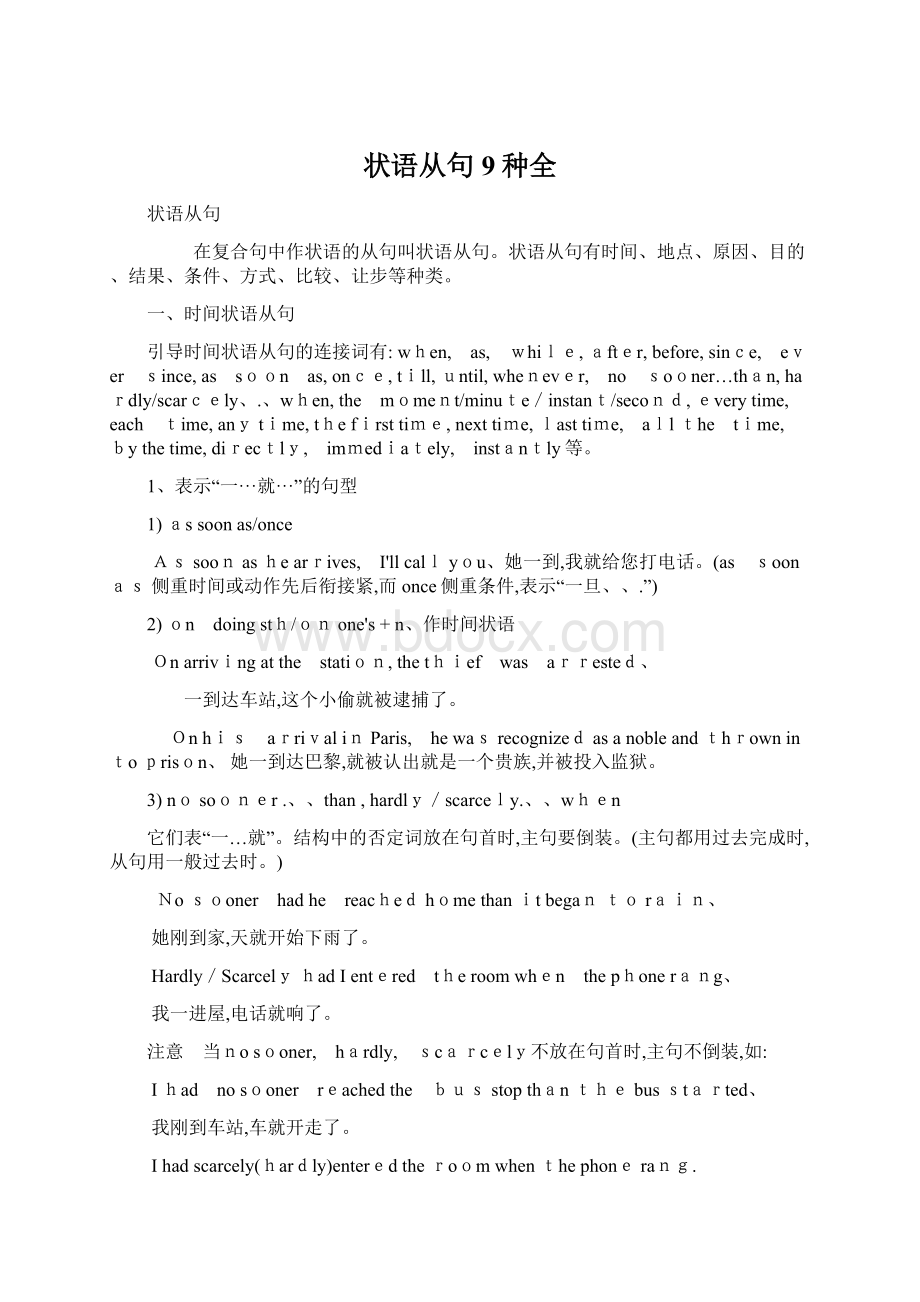状语从句9种全.docx
《状语从句9种全.docx》由会员分享,可在线阅读,更多相关《状语从句9种全.docx(16页珍藏版)》请在冰豆网上搜索。

状语从句9种全
状语从句
在复合句中作状语的从句叫状语从句。
状语从句有时间、地点、原因、目的、结果、条件、方式、比较、让步等种类。
一、时间状语从句
引导时间状语从句的连接词有:
when, as, while,after,before,since, ever since,as soon as,once,till,until,whenever, no sooner…than,hardly/scarcely、.、when,the moment/minute/instant/second,everytime,each time,anytime,thefirsttime,nexttime,lasttime, allthe time, bythetime,directly, immediately, instantly等。
1、表示“一···就···”的句型
1)assoonas/once
Assoonashearrives, I'llcallyou、她一到,我就给您打电话。
(as soonas侧重时间或动作先后衔接紧,而once侧重条件,表示“一旦、、.”)
2)on doingsth/onone's+n、作时间状语
Onarrivingatthe station,thethief was arrested、
一到达车站,这个小偷就被逮捕了。
Onhis arrivalinParis, hewasrecognizedasanobleandthrownintoprison、她一到达巴黎,就被认出就是一个贵族,并被投入监狱。
3)nosooner.、、than,hardly/scarcely.、、when
它们表“一…就”。
结构中的否定词放在句首时,主句要倒装。
(主句都用过去完成时,从句用一般过去时。
)
Nosooner hadhe reachedhomethanitbegantorain、
她刚到家,天就开始下雨了。
Hardly/ScarcelyhadIentered theroomwhen thephonerang、
我一进屋,电话就响了。
注意 当nosooner, hardly, scarcely不放在句首时,主句不倒装,如:
Ihad nosooner reachedthe busstopthanthebusstarted、
我刚到车站,车就开走了。
Ihadscarcely(hardly)enteredtheroomwhenthephonerang.
4)themoment,the instant, theminute, thesecond
The momentI sawhim,Irecognizedhim、
我一瞧见她,就认出了她。
We'll leavetheminute youareready、
您一准备好,我们就出发。
5)有些副词如:
instantly, immediately, directly可用作连词,后接从句。
I leftimmediately the clockstruck 5.
我刚走,钟就敲了五点。
2.when,while,as引导时间状语从句
1)when的用法
①when既可指时间点,也可指时间段(即:
从句动词可以就是短暂的也可就是延续的);主从句动作可同时也可先后发生。
Iwasthin whenIwas achild.
当我就是个孩子的时候,我很瘦。
ItwasrainingwhenIarrived、我到达时,天正在下雨。
②在when引导时间状语从句时,如果从句主语与主句主语相同或为it,且从句有be动词,则从句可省主语与be动词,如:
When (youare)introuble,youcanvisitthisman、
当您有麻烦时,可以找这个人。
Sheisalwayslistening to musicwhen(sheis) doingherhomework、 当她做作业时,总就是听音乐。
③when在下列结构中, 译成“这时”,它引导的就是并列句
beabout to do、、.when,bedoing、、、when,haddone ···when,
beonone'sway、、、when,be onthepointofdoing.、.when(参见“连词”部分when的用法)
2)while用法
while只能指一段时间,从句中的动词必须就是延续性动词。
强调某一段时间内发生主句动作,相当于duringthe time that、、、.
Mymotherwascooking whileIwasdoingmyhomework.
当我在做作业时,妈妈在做饭。
Iamsafe whileIam here.我在这儿的时候,我很安全。
注意while除引导时间状语从句外,还引导对比句,作“然而”讲;并可在句首引出让步状语从句作“虽然···但”讲。
I likewatchingTV,while helikesreading、
我喜欢瞧电视,而她喜欢读书。
While he hashisowncar,heoften usesmine、
尽管她自己有车,她却常用我的。
3)as的用法
① as引导时间状语从句时常可与when换用,但较强调同时发生,多指短暂动作。
As Ileftthe house,Iforgotthekey、我离家时,忘了带钥匙。
②as还可说明两种正在发展或变化的情况,“随着、、、”的意思,表时间的推移。
如:
AsIgetolder,Iget moreoptimistic、
随着年龄的增长,我变得更加乐观。
③as表“一边…一边…”,引出伴随动作。
Hehurriedhome,looking behindashewent.
她匆忙地回家,边走边往后瞧。
④用以强调两个动作紧接着发生。
As hewasgoingout,itbegantorain、
当她出去的时候,天开始下雨了。
⑤as有时引出一个名词,相当于一个时间状语从句。
Asaboy(whenhewas aboy),he washopelessatmaths、
当她就是孩子时,她对数学失去希望。
3、before引导的时间状语从句
①before引导的时间状语从句不用否定式谓语。
Before theygotto thebusstop,the bushadgone.
在她们到达公共汽车站之前,公共汽车已经走了。
②在“Itbe+ 时间段+before从句”句型中,肯定句译成“…(之后)才”,否定句译成“…就”。
该句型有一般过去时、过去将来时、一般将来时三个时态,且有否定句。
It willbesome timebefore、、、 do..、
Itwassometimebefore、.、did、.、
Itwouldbe sometimebefore、、、did.、、
Itwaslongbefore、、.did.、、“很久才···”
Itwasn'tlong before.、、did、、.“不久就、.、”
It will bemanyyearsbeforethechemicalsstart toescapefrom
thecontainers、多年以后化学物质才开始从容器中逃逸。
It wasnotlongbefore hecame back、不久她就回来了。
Itwasa longtimebefore hegot tosleep again、
很久她才再次入睡。
Itwas aweekbeforehe couldtellhis story、
一个星期后她才能讲述她的经历。
Itwasn'tlongbefore he toldusabout himself、
不久她就给我们讲述了她自己的故事。
▲before可译成“未来得及”
Hehad measuredmebefore Icouldgetaword、
我还未来得及插话,她就量好了尺寸。
▲before可译成“趁着还没”
I'llwriteitdownbeforeIforget、
趁着还没忘我要把它写下来。
4、until与till
1)“延续性动词肯定式+until”表示“动作延续到…为止,”译为“直到…为止”,如:
I waitedforhimuntilhecame back、 我一直等到她回来。
2)“终止性动词的否定式+until”表示“直到···才”。
Hedidn't go tobeduntilhe hadfinishedhiswork、 直到完成工作她才睡觉。
3)用于强调句式“Itisnotuntil、、.that 、、、”
It wasnotuntiltheprofessorcamethatwe beganthe experiment.
在教授到来之后,我们才开始实验。
4)notuntil放在句首时,主句倒装。
Notuntil he graduateddid hesucceedinobtainingthiscompound、直到她毕业她才成功获得这种化合物。
注意句首与强调句中要用until,而不用till;not、、、until、、.句型中不用till。
5.since引导时间状语从句,意为“自从…时起”,主句要用完成时。
Mr、Lihasbeenheresincehecame back、
自从李先生回来以后,她一直在这儿。
Ihaven't heardfromhimsincehe livedhere、
自从她住在这儿以来,我就没有收到过她的来信。
I'veknownMr、Smith since I wasaboy、
我小的时候就认识史密斯先生了。
6、时间状语从句的省略式
当时间状语从句的主语与主句主语相同或为it,从句又含be动词时,从句可省略主语与be动词。
在不产生歧义时,连词也可省去。
如:
Once (itis)seen,itcannever beforgotten、
一旦被瞧见过,永远也不会被忘记。
二、地点状语从句
1、地点状语从句主要由where,whereveranywhere, everywhere引导。
Wemustcampwherewe cangetwater、
我们必须在能找到水的地方露营。
Iwill followyouwherever yougo、
无论您到何处我都要跟随您。
2、地点状语从句与定语从句的区别:
where引导定语从句,从句前应有一个表示地点的名词作先行词。
Gobackwhereyoucame from.(where引导地点状语从句)
Gobacktothevillagewhereyoucamefrom、
(where引导定语从句,village为先行词)
三、原因